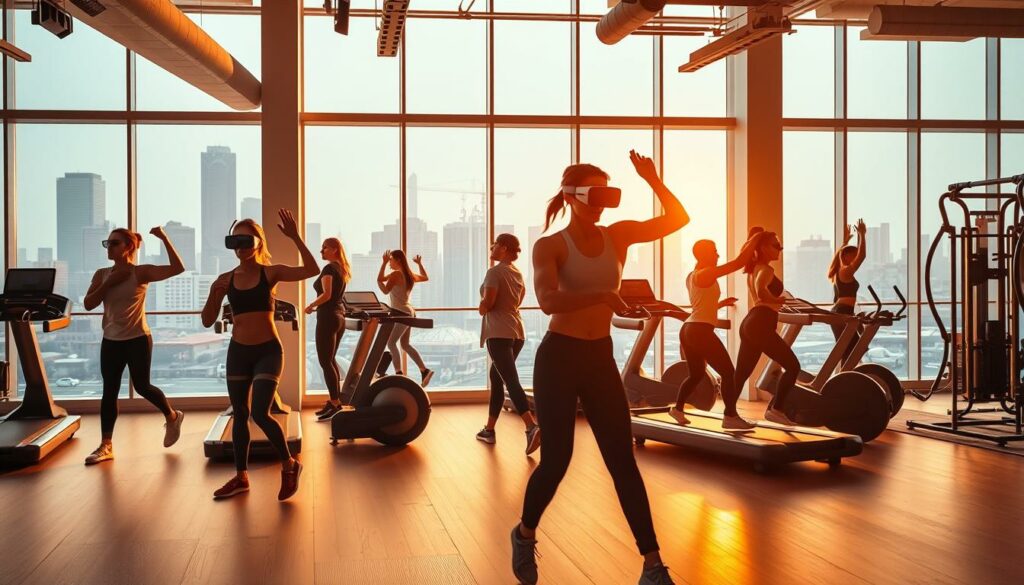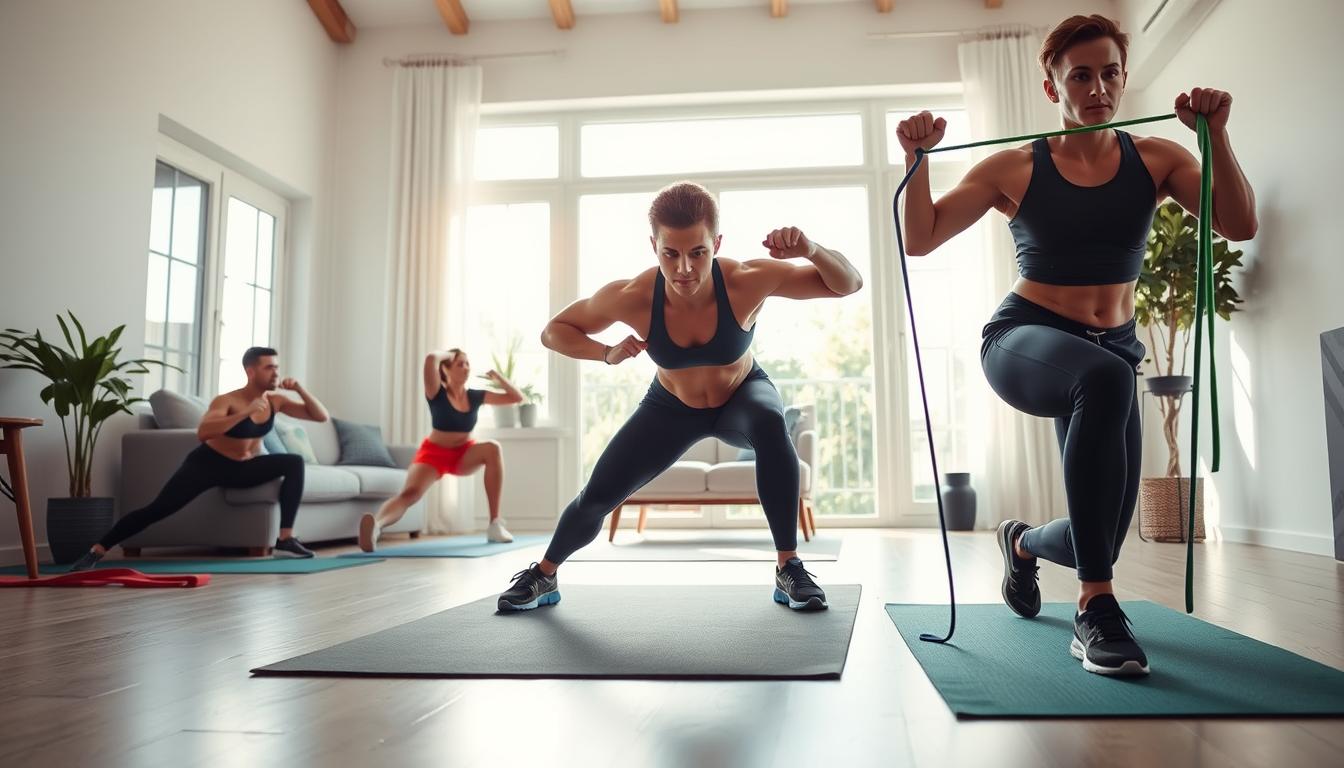Are you finding it hard to fit in a workout with your busy schedule in 2025? You’re not alone. Many struggle to find time for the gym with their demanding lives. But what if you could get fit with just a few minutes of activity at a time?
This is where exercise snacking comes in – a fitness trend for busy people.
Exercise snacking means doing short bursts of activity all day. It’s a way to stay active without needing to go to the gym. As fitness trends change, more people are trying it out. It’s a simple way to get healthier without feeling stressed.
Key Takeaways
- Short bursts of activity can boost fitness.
- Exercise snacking fits into busy schedules.
- This approach is part of emerging fitness trends.
- It helps improve overall health without a traditional gym routine.
- Busy people can benefit from incorporating exercise snacking into daily routines.
Understanding Exercise Snacking in the Modern World
Time is precious, and exercise snacking is a great alternative to long workouts. It’s becoming popular because it’s flexible and easy to fit into a busy schedule.
Defining the Exercise Snacking Concept
Exercise snacking means adding short physical activities to your day. These quick workouts last from seconds to minutes and can be done anywhere, anytime.
Origins and Evolution of Micro-Workouts
This idea started because people wanted workouts that didn’t take much time. It combines ideas from HIIT and bodyweight exercises.
How Exercise Snacking Differs from Traditional Workouts
The main difference is in how long and often you work out. Exercise snacking is quick and flexible, unlike long, traditional workouts.
Time Efficiency vs. Traditional Training Sessions
Exercise snacking is quick, making it perfect for busy days. It’s a big change from traditional workouts that take up a lot of time.
| Workout Type | Duration | Frequency |
|---|---|---|
| Exercise Snacking | Few seconds to minutes | Multiple times a day |
| Traditional Workouts | 30 minutes to several hours | Several times a week |
The Evolution of Fitness Trends Leading to2025
As we near 2025, the fitness world is changing fast. This is thanks to global events and new tech. Now, people want workouts that are flexible, easy to get to, and made just for them.
Post-Pandemic Fitness Adaptations
The pandemic made us all start doing quick workouts at home. This change has made digital fitness and no-equipment exercises more popular.
Technology Integration in Micro-Workouts
Technology is key in the new fitness trends. It’s bringing us AI for workout plans and virtual reality for fun exercises.
AI-Powered Workout Suggestions
AI is making workouts personal. It plans exercises based on what you like, your fitness level, and your goals. This keeps you motivated and helps you get better results.
Virtual Reality Exercise Snacking
Virtual reality is changing how we work out. It lets us have fun, immersive exercises anywhere. VR snacking makes staying active fun and engaging.
| Fitness Trend | Pre-Pandemic | Post-Pandemic |
|---|---|---|
| Gym-based workouts | Dominant | Declining |
| Home-based workouts | Niche | Mainstream |
| Digital fitness solutions | Emerging | Booming |

Why ‘Exercise Snacking’ Is Perfect for Busy People in2025
In 2025, ‘exercise snacking’ is changing the game for those with tight schedules. The world today demands more of our time, making it hard to fit in big workouts. ‘Exercise snacking’ breaks down exercise into short, easy-to-fit-in sessions.
The Increasing Time Constraints of Modern Life
Today, time management is key. Busy folks struggle to find time for big workouts. ‘Exercise snacking’ helps by turning exercise into short, doable sessions that fit into a busy day.
Compatibility with Remote and Hybrid Work Models
Remote and hybrid work has made life more flexible but also busier. ‘Exercise snacking’ is great for this, letting you move around during the day. It keeps you active and boosts your work performance.
Integration with Digital Wellness Platforms
‘Exercise snacking’ works well with digital wellness platforms. These platforms guide you through quick workouts and remind you to move. They help you stay well-rounded in your wellness journey.
Workplace Wellness Programs Supporting Micro-Exercise
More companies are adding ‘exercise snacking’ to their wellness programs. They use digital tools and apps to encourage short, active breaks. For example, some offer apps with exercises for all fitness levels and settings.
| Workplace Wellness Program Features | Benefits |
|---|---|
| Digital Micro-Workout Apps | Convenient access to short exercise routines |
| Reminders to Move | Reduces sedentary behavior |
| Customizable Exercise Plans | Caters to different fitness levels and needs |

In conclusion, ‘exercise snacking’ is ideal for busy lives in 2025. It’s flexible, fits modern work styles, and works with digital wellness tools. Adding short exercise breaks to your day can boost your health and work performance.
The Science Behind Short-Duration Exercise Benefits
Scientists are studying how short workouts affect our health. They found that short exercises can greatly improve our well-being. Adding these activities to our daily lives can lead to big health benefits.
Metabolic Impacts of Brief Exercise Bursts
Short workouts, or “exercise snacks,” are good for our metabolism. Research shows they can make our bodies better at handling sugar and insulin. This can lower the risk of getting type 2 diabetes.
Improved metabolic health is a key benefit of short workouts. Adding brief exercises to your day can boost your metabolic function.
Cognitive Benefits of Movement Breaks
Short exercises also help our minds. They can improve focus, increase productivity, and help with mental health. They can reduce stress levels.
“Exercise is a celebration of what your body can do, not a punishment for what you ate.” – Unknown
Cumulative Effects of Multiple Exercise Snacks
Doing many short workouts a day can have big health benefits. Studies show they can improve heart health, boost energy, and help with weight management.
Research-Backed Health Outcomes
Many studies have looked into the health benefits of short workouts. They found that regular “exercise snacking” can improve overall health. This includes lower blood pressure, stronger muscles, and better mental health.
Understanding the science behind short workouts can help you make better choices. You can add “exercise snacks” to your day for a healthier, more active life.
Designing Your Personal Exercise Snacking Strategy
Creating a personalized exercise snacking strategy starts with knowing your daily routine. It’s about finding chances to move more. This way, you can fit exercise routine into your busy life.
Assessing Your Schedule for Exercise Opportunities
To begin, look at your daily schedule for times to move. This means:
- Spotting times when you’re not active
- Looking at your daily tasks and plans
- Finding ways to swap sitting for moving
Conducting a Time Audit for Movement Breaks
A time audit shows how you spend your day. For a week, track your activities in 30-minute blocks. This will show you time management chances for exercise snacks.
Setting Realistic Micro-Workout Goals
After finding exercise chances, set realistic micro-workout goals. These should be easy to reach and match your fitness goals. Start small and grow your goals over time.
Creating Exercise Snack Triggers in Your Daily Routine
To make exercise snacking a habit, create reminders. This is where habit stacking helps.
Habit Stacking Techniques for Exercise Adherence
Habit stacking links new exercise habits to daily routines. For instance, do squats with your coffee breaks or stretch after brushing your teeth. By linking exercise to habits, you’re more likely to keep up with it.
10 Effective Exercise Snacks for Different Environments
Finding time for exercise can be tough with busy lives. But, ‘exercise snacking’ is a great solution. These short workouts fit into any setting, helping you stay active all day.
Office-Based Movement Snacks
Many spend their days at the office. Luckily, there are exercises you can do right at your desk. Desk exercises are perfect for staying active.
Desk-Compatible Strength Exercises
Try chair squats, desk push-ups, or leg raises while sitting. These exercises work your muscles without needing any gear.
Standing Meeting Movement Options
Make standing meetings more active by adding calf raises or wall push-ups. These moves are easy to do and boost your daily activity.
Home-Friendly Micro-Workouts
At home, you can move freely and do various exercises. Kitchen counter exercises are super convenient.
Kitchen Counter Exercises While Cooking
Do countertop push-ups or chair dips while waiting for food. These exercises work many muscles at once.
On-the-Go Exercise Options
Always on the move? You can fit in exercise. Try bodyweight squats or jumping jacks during breaks.
Digital Meeting Exercise Integrations
Digital meetings are common with remote work. Stay active with seated leg lifts or arm circles. This keeps you moving and focused.
Adding these exercise snacks to your day improves your fitness and health, no matter where you are.
Equipment-Free Exercise Snacks Anyone Can Do
Adding exercise to your day is now easier than ever. You can do quick workouts anywhere. This makes it simple to stay active, even when you’re busy.
Bodyweight Exercise Sequences
Bodyweight exercises help you build strength without any equipment. You can do them at home, work, or while traveling.
2-Minute Strength Circuits
A 2-minute strength circuit is easy. Try doing push-ups, squats, and lunges. Start with 20 seconds of push-ups, rest for 20 seconds, then do squats or lunges. Repeat this to increase your strength and endurance.
Mobility-Focused Movement Breaks
Mobility exercises improve your range of motion and reduce stiffness. Adding these to your daily routine boosts your flexibility.
Joint Health Mini-Routines
Doing neck stretches, shoulder rolls, and ankle rotations keeps your joints healthy. These are ideal for office workers who sit a lot.
Cardio Bursts Without Equipment
You don’t need equipment to raise your heart rate. Try jumping jacks, burpees, or running in place.
Heart Rate Elevating Quick Sequences
Jumping jacks, followed by burpees, and high knees can get your heart racing. These sequences are excellent for your heart health and can be done in minutes.
Leveraging Technology to Enhance Your Exercise Snacking
Technology is changing how we exercise. It can make your workouts better, more fun, and fit your busy life. Digital tools and platforms can help you get the most out of your exercise snacks.
Apps Designed for Micro-Workout Reminders
Apps can remind you to exercise. They fit your schedule, so you move at the best times. This keeps you active all day.
2025’s Top Exercise Snacking Applications
Top apps for exercise snacks offer personalized workouts and reminders. Fitbit Coach and Nike Training Club are great. They have short, effective workouts you can do anywhere.
| App Name | Key Features | Platform |
|---|---|---|
| Fitbit Coach | Personalized video workouts, audio guidance | iOS, Android |
| Nike Training Club | Variety of workouts, celebrity trainers | iOS, Android |
| JEFIT | Large exercise database, customizable routines | iOS, Android |
Wearable Technology Integration
Wearable tech tracks your workouts better. Smartwatches and fitness trackers monitor your activity and heart rate. They even alert you to move if you’re sitting too long.
Smart Clothing and Accessories for Movement Tracking
Smart clothes and accessories track your movements. They give feedback on your workouts. These products make tracking your activity easy and comfy.
Virtual Coaching for Brief Exercise Sessions
Virtual coaching helps with your workouts. It offers personalized guidance through video apps or fitness platforms. You get feedback on your form and technique in real-time.
Technology can improve your exercise routine. It makes workouts more effective and fun. With apps, wearables, and virtual coaching, you can reach your fitness goals.
Overcoming Common Exercise Snacking Challenges
Adding exercise snacking to your daily life can face several hurdles. It needs consistency and flexibility to work well.
Maintaining Consistency Despite Interruptions
Keeping up with your exercise plan can be tough. Unexpected things or busy days often get in the way.
Backup Plans for Busy Days
It’s key to have backup plans for those days. Look for shorter, quicker exercises that fit into tight schedules.
Managing Workplace Perceptions
Another hurdle is dealing with what others think about your exercise breaks. Some might see them as a waste of time.
Normalizing Movement Breaks in Professional Settings
To change this, explain the good of movement breaks. You can also make them part of team activities.
Avoiding Exercise Snacking Plateaus
Staying on track with your exercise snacking is vital. Mix up the exercises to keep things interesting and challenging.
Progressive Overload in Brief Exercise Sessions
Use progressive overload in your short workouts. This means making the exercises harder as you get stronger.
Tracking Progress and Measuring Results
To get the most from exercise snacking, tracking your progress is key. It keeps you motivated and shows how these short workouts help your health.
Appropriate Metrics for Exercise Snacking Success
Measuring your exercise snacking success goes beyond just step counts. Comprehensive movement metrics give a deeper look at your progress.
Digital Tools for Monitoring Cumulative Exercise
Using technology makes tracking easier. Wearable devices and mobile apps track your micro-workouts, helping you see how you’re doing.
Recognizing Non-Scale Victories
It’s important to see the non-scale victories too. Non-scale victories include better mental function and mood boosts.
Cognitive and Mood Improvements from Regular Movement
Regular exercise snacking improves your mind and mood. Seeing these benefits can keep you going with your routine.
Combining Exercise Snacking with Traditional Workouts
Mixing exercise snacking with regular workouts is a smart way to stay fit, even when you’re busy. It blends the quick energy boosts of short exercises with the full benefits of longer sessions.
Creating a Balanced Fitness Approach
A balanced fitness plan looks at both short-term goals and long-term health. It includes cardio, strength training, and flexibility exercises. This mix helps you stay active and healthy.
Here’s a weekly fitness plan example:
| Day | Traditional Workout | Exercise Snacks |
|---|---|---|
| Monday | 30-minute jog | 3×10-minute stretching breaks |
| Tuesday | Strength training | 2×5-minute desk exercises |
| Wednesday | Rest day | 4×5-minute walking breaks |
Weekly Planning for Varied Exercise Types
Plan your week with different workout days. For example, use Monday, Wednesday, and Friday for strength training. Use Tuesday and Thursday for cardio. Add exercise snacks throughout the day.
Using Exercise Snacks as Supplements to Longer Sessions
Exercise snacks boost your longer workouts. For example, they can prepare your body for a big run or bike ride on the weekend.
Periodization Strategies for Busy Professionals
Periodization means changing your workout intensity and volume. This prevents plateaus and overtraining. Busy people might alternate high and low intensity weeks or focus on different fitness areas each month.
Seasonal Adjustments to Your Movement Plan
Seasonal changes in your workout plan keep things interesting. For example, do more outdoor activities in summer and indoor exercises in winter.
Conclusion: Embracing the Future of Fitness Flexibility
Looking ahead to 2025, exercise snacking is set to be a key part of fitness. It lets busy people fit in physical activity, even with tight schedules. This way, you get to enjoy the perks of moving more, like better health and sharper thinking.
Exercise snacking is great because it fits into many lives. You can do it at home, at work, or while on the move. With new tech, like apps and wearables, it’s getting even easier to stay active.
Choosing exercise snacking means you’re looking after your health and building a lasting fitness habit. As fitness trends change in 2025 and later, this flexible method will keep helping you stay healthy and balanced.


